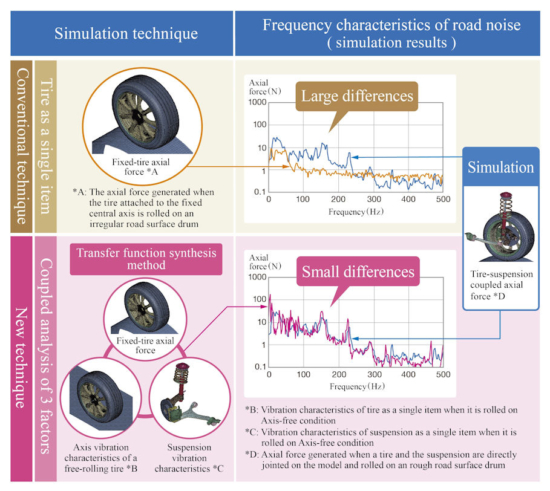SRI improves noise predictability for tyre development
 (Source: SRI)
(Source: SRI)
Sumitomo Rubber Industries, Ltd. (SRI) has unveiled a new technique for predicting noise generated by the combined vibration of tyres and vehicle. By simulating how tyres roll when in motion and applying the lessons learned, SRI anticipates that both tyre and vehicle manufacturers will be able to reduce their products’ noise emissions.
The tyre maker intends to use the process to more rapidly respond to user requirements, employing it in a model-based development that leverages computer simulations to minimise the requirement for physical prototypes and extensive testing.
Conventional test methods inadequate
Tyres transmit irregularities in the road surface to the vehicle as road noise, affecting passenger comfort. The absence of engine noise makes this phenomenon even more noticeable in electric vehicles, elevating road noise’s significance as a factor that needs to be addressed.
Tyre developers already work with various standalone tyre simulation techniques when attempting to reduce road noise, however SRI comments that when using these methods, it is difficult to predict noise when a tyre is actually fitted to a vehicle.
Combining data to predict overall movement
More recently, SRI developed a technique for predicting road noise generated through the combination of tyre and vehicle. It uses the transfer function synthesis method to combine the individual performance of the tyre and that of the vehicle. This method breaks down complex data, expresses the movement of each part as a transfer function, and then combines them to predict overall movement.
This technique enables a simulation to assess the axis vibration characteristics of a free-rolling tyre when in motion. Furthermore, by comparing the axis vibration characteristics of a stationary tyre with those of a rolling tyre, SRI has confirmed that factors such as gyro effect – a phenomenon that hinders changes to a rotating object’s posture – create differences in vibration characteristics. This in turn confirms the effectiveness of using the transfer function synthesis method with rolling tyres.
SRI presented its findings at the 2023 JSAE (Society of Automotive Engineers of Japan, Inc.) Annual Congress, and a patent for the simulation is now pending (Kokai No. 2022-37666).
Tyre development with 2 techniques
SRI summarises that its new technique simplifies the task of predicting road noise performance by using a transfer function to couple tyre and vehicle vibration characteristics. It points out that the transfer function is more commonly available than sensitive vehicle information. Additionally, this technique can reduce the number of tests that need to be performed with an actual vehicle fitted with physical prototype tyres, which will shorten development while using fewer resources.
The tyre maker plans to use this new noise simulation technique alongside its Tire Aerodynamic Simulation technique, which reduces energy consumption in electric vehicles. The two techniques will help SRI “promptly respond to a variety of ever-changing user needs.”





Comments